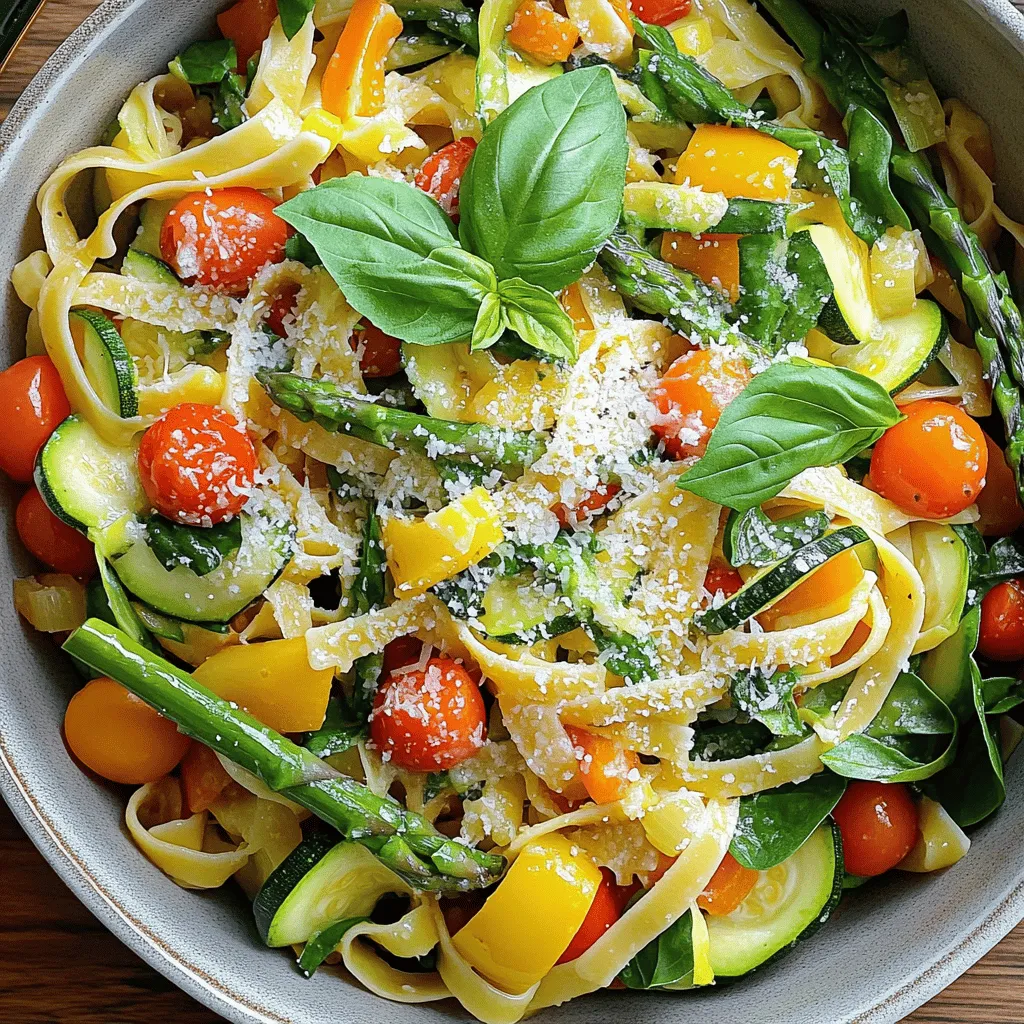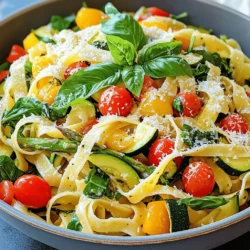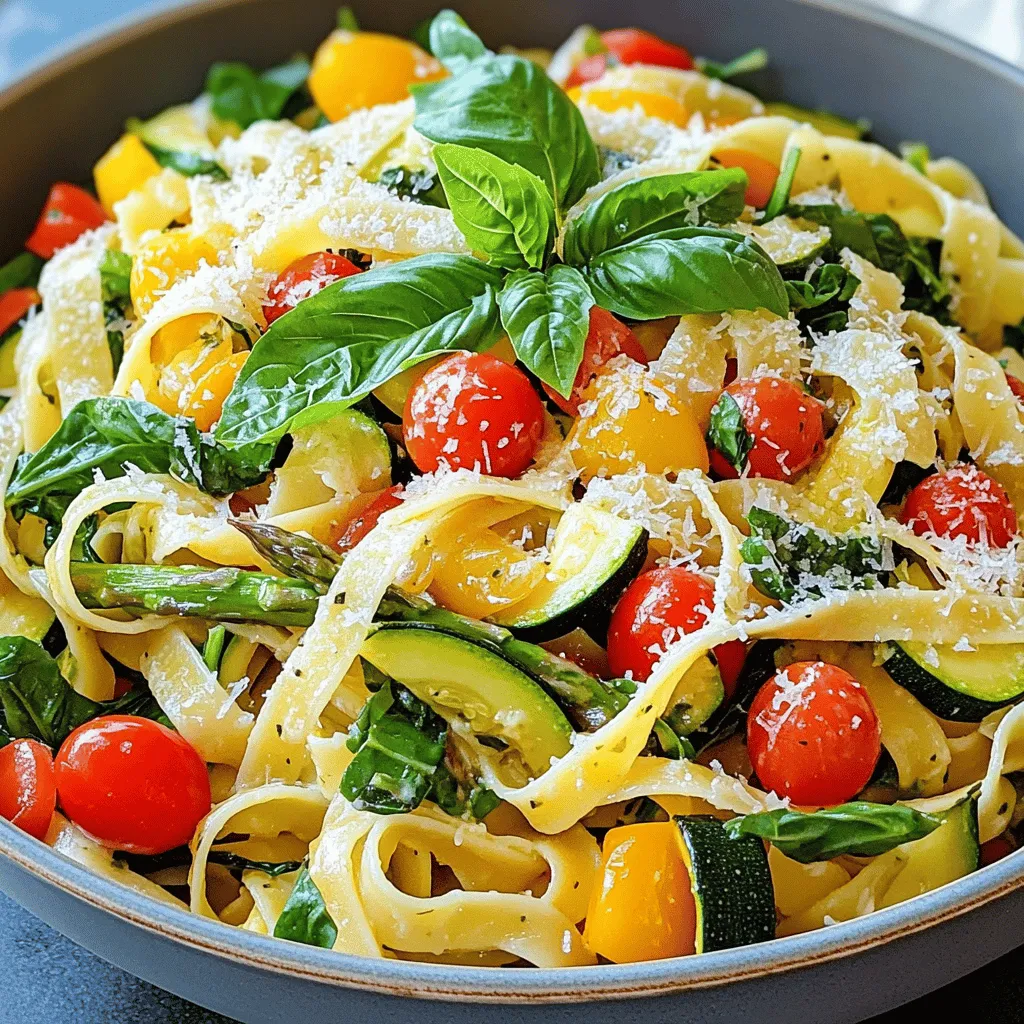Are you ready to dive into a bowl of fresh, vibrant flavors? This Vegetarian Pasta Primavera is the perfect dish for anyone seeking a healthy and tasty meal. Packed with colorful veggies and simple ingredients, it’s a feast for the eyes and the palate. Whether you’re a seasoned chef or a beginner, I’ll guide you through each step. Let’s make a delightful dish that celebrates the best of vegetarian cooking!
Ingredients
Main Ingredients
- 8 oz. pasta (fettuccine or penne)
- 2 tablespoons olive oil
- 1 small red onion, thinly sliced
- 2 cloves garlic, minced
The main ingredients set the stage for a tasty dish. Pasta is the base. Choose either fettuccine or penne for a great bite. I love the way the sauce clings to each shape. Olive oil adds richness and helps to sauté the veggies. Red onion gives a sweet flavor, while garlic adds a nice kick.
Vegetables Used
- 1 zucchini, sliced into half-moons
- 1 bell pepper (red or yellow), sliced
- 1 cup cherry tomatoes, halved
- 1 cup asparagus, trimmed and cut into 2-inch lengths
- 1 cup baby spinach
The vegetables bring life and color to this dish. Zucchini offers a mild taste and soft texture. Bell peppers add sweetness and crunch. Cherry tomatoes burst with flavor and provide a juicy contrast. Asparagus adds a nice crispness, while baby spinach wilts beautifully into the mix.
Seasoning and Garnishes
- 1 teaspoon Italian seasoning
- Salt and pepper to taste
- ½ cup grated Parmesan cheese (optional for serving)
- Fresh basil leaves for garnish
Seasoning is key to making this dish pop. Italian seasoning brings classic flavors. Salt and pepper enhance all the tastes. For a creamy touch, sprinkle Parmesan cheese on top. Fresh basil adds a fragrant finish and brightens every bite.
Each ingredient plays a part in this dish. Together, they create a fresh and flavorful experience. Enjoy the vibrant colors and tastes of this vegetarian pasta primavera!
Step-by-Step Instructions
Cooking the Pasta
First, you need to boil water. Use a large pot and add salt. Bring it to a rolling boil. Next, add 8 oz. of pasta. You can use fettuccine or penne. Cook the pasta according to the package instructions. Aim for that perfect al dente texture. When the pasta is done, set aside a cup of pasta water. This water helps to make the sauce later. Then, drain the pasta in a colander and set it aside.
Sautéing the Vegetables
Now, let’s move on to the vegetables. Heat 2 tablespoons of olive oil in a large skillet over medium heat. Add 1 small red onion, thinly sliced, and 2 minced garlic cloves. Sauté for 2-3 minutes. The onion should be translucent and fragrant.
After that, it’s time to add the rest of the veggies. Stir in the sliced zucchini, bell pepper, cherry tomatoes, and asparagus. Cook this mix for about 5-7 minutes. You want the veggies to be tender but still crisp. This keeps them vibrant and fresh.
Mixing It All Together
Once your veggies are ready, it’s time to add the spinach. Toss in 1 cup of baby spinach and 1 teaspoon of Italian seasoning. Cook for another 2 minutes. The spinach will wilt down nicely. Season everything with salt and pepper to taste.
Now, add the drained pasta to the skillet. Toss the pasta with the vegetable mixture until everything is well combined. If the mix seems dry, gradually add a little reserved pasta water. This will help you reach your desired consistency.
And there you go! You’ve got a colorful and tasty Vegetarian Pasta Primavera ready to enjoy.
Tips & Tricks
Cooking Pasta Perfectly
To get that perfect al dente texture, cook the pasta until it is just firm. Check the package for timing but start tasting a minute or two early. When you bite it, it should feel slightly firm but not hard. Remember to reserve some pasta water before draining. This starchy water helps bind the sauce and pasta together later.
Enhancing Flavor
To make your Pasta Primavera even tastier, try adding fresh herbs like parsley or thyme. A dash of red pepper flakes gives it a nice kick. For cheese, if you want to switch things up, try using feta or goat cheese instead of Parmesan. They offer a different taste that can really elevate your dish.
Presentation Tips
Serve your pasta in large, shallow bowls to make it look inviting. Top with fresh basil and a sprinkle of cheese for color. A drizzle of high-quality olive oil right before serving adds a lovely shine and flavor. It’s a simple touch that makes your dish look and taste more gourmet.

Variations
Ingredient Substitutions
You can switch up the veggies based on what you have. Try using broccoli, carrots, or peas for new flavors. Seasonal veggies like bell peppers and zucchini are great in summer. In fall, consider adding squash or mushrooms.
For gluten-free options, look for pasta made from rice or corn. These alternatives cook well and taste great in this dish.
Adding Protein
To make your pasta primavera heartier, add protein. Chickpeas are a fantastic choice. They add texture and flavor. Simply toss them in with the veggies.
Tofu is another option. Cube it and sauté it with the onions and garlic. You can also use vegetarian sausage. Sliced sausage adds a savory kick.
Saucing It Up
The sauce can change the whole dish. For a quick fix, use store-bought marinara or pesto. These sauces mix well with the veggies and pasta.
If you like cream, try a light Alfredo sauce. A splash of cream changes the texture nicely. You can even mix both tomato and cream sauces for a rich flavor.
Storage Info
Short-Term Storage
To keep your leftover pasta primavera fresh, store it in an airtight container. Make sure it is cool before sealing. This dish lasts up to three days in the fridge. Check for any signs of spoilage before eating.
Freezing Instructions
If you want to save it for later, freezing works well. Place the pasta primavera in freezer-safe containers. Leave some space at the top, as it may expand. This dish can stay good for up to three months in the freezer. To reheat, thaw overnight in the fridge. Then, warm it in a skillet over low heat. Add a splash of water to help regain moisture.
Meal Prep Tips
Prepping ingredients ahead of time can save you effort. Chop your vegetables and store them in the fridge. You can also cook the pasta a day in advance. Just toss it with a bit of olive oil to prevent sticking. Batch cooking is a great idea for quick meals. Make a large batch and divide it into servings. Store them in containers for easy access during the week.
FAQs
Can I make Vegetarian Pasta Primavera ahead of time?
Yes, you can make Vegetarian Pasta Primavera ahead. This dish keeps well in the fridge. To prepare in advance, cook the pasta and veggies separately. Let them cool before storing. Use airtight containers to keep them fresh. When you’re ready to eat, just reheat everything in a skillet. Add a splash of reserved pasta water to keep it moist.
What type of pasta is best for Pasta Primavera?
Fettuccine and penne are great choices for Pasta Primavera. Fettuccine holds the sauce well, while penne captures bits of veggies inside. You can also use whole grain or gluten-free pasta if you prefer. Just make sure to cook it until al dente for the best texture.
Is this recipe vegan-friendly?
This recipe can easily become vegan. Simply leave out the Parmesan cheese, or use a vegan cheese substitute. You can also add more vegetables or plant-based protein, like chickpeas or tofu, to boost flavor and nutrition. This way, you keep all the taste without any dairy.
This blog post covered how to make a tasty vegetarian pasta primavera. We explored main ingredients, step-by-step cooking methods, and tips to enhance flavor. I also shared smart storage tips and variations to suit your taste. You can easily swap ingredients or add protein for more options. Cooking pasta primavera lets you enjoy a fresh, colorful meal that is quick to prepare and full of flavor. Dive in and create your own version today!


